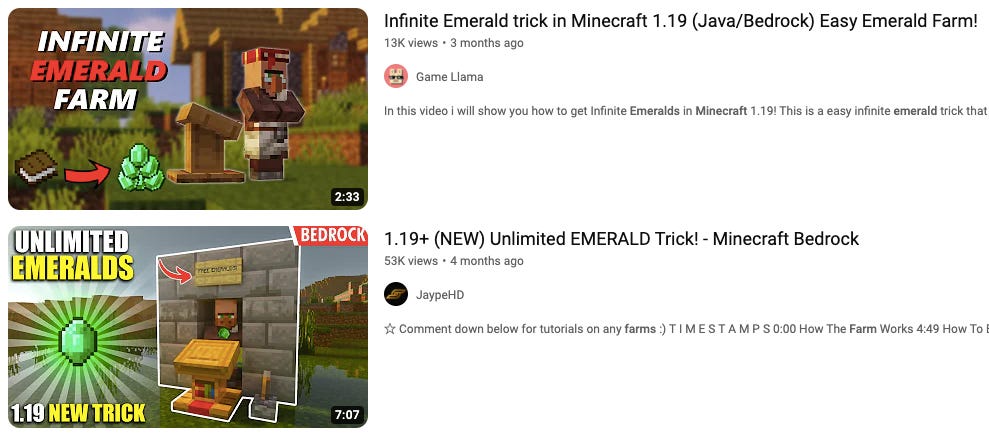Money must be difficult to produce. The value of each monetary unit in circulation comes from the difficulty in producing a new monetary unit of the same type. If new money isn’t difficult to produce, then existing money will lose its value rapidly.
That’s why fiat currencies, such as the dollar, euro, and yen, are quickly headed toward worthlessness. Their issuers can (and do!) create new units at will. Quickly. And for no effort.
We can see that exact process unfold in the most popular video game in the world: Minecraft.
Minecraft boasts an in-game “economy” in which the player can trade with NPC’s (Villagers and the Wandering Trader) to acquire various resources. The prices of these resources are quoted in Emeralds, equivalent to dollars in the United States.
Figure 1. Minecraft uses Emeralds. Amazon uses dollars.
That pricing system works well enough for single player games, but a serious problem emerges in multiplayer games, and that’s the key point of our analysis.
Emerald Farms
An integral (and intentional) feature of Minecraft is “farming” resources. A player can spend a few minutes (or a few hours) creating environments and leveraging certain game mechanics to produce resources in large quantities with little-to-no on-going player input. This works for food items, like carrots (hence the name “farming”), and non-food items like Emeralds.
Figure 2. It feels like there's infinite videos on how to create Infinite Farms
Under normal conditions, if you have access to infinite carrots, and someone tries to sell you a carrot, there’s pretty much nothing you would pay for that carrot.
In other words, other people’s carrots are worthless to you because you can create infinite carrots on your own. And since everyone feels this way, carrots have no “market value” to anybody.
But it isn’t just carrots. It’s everything that can be farmed, including Emeralds.
So what happens on a multiplayer server?
As if by magic, every Minecraft server – thousands of them – all found the same solution: Diamonds.
Diamonds can’t be farmed. They can only be found – either by mining underground or by searching loot chests in dangerous and remote places. In other words, diamonds take a lot of energy and effort to acquire. And that effort can’t be meaningfully mitigated over time.
As a result, diamonds function as money.
The same process has unfolded countless times in the real world:
People have tried using inferior monies, like rocks, beads, and sea shells. Over time, people (usually from another tribe) find a way to produce this “money” very cheaply. They’re effectively able to buy up all the goods and services in the tribe. This impoverishes the tribe and enriches whoever produced the easy money.
Consider the perspective that you and I and all the civilians of the world are a tribe. We use fiat currencies – dollars, euros, yen – as our money, and we must work to acquire it. Now consider that another tribe – the central bankers and their government partners – are able to produce our money very cheaply. They are in the decades-long process of impoverishing all the citizens of the world, just as an “advanced” tribe has impoverished a “primitive” tribe countless times before.
It’s like we’re all working for Emeralds, but only the government is able to farm them.
So what do we do about it?
Minecraft proves instructive yet again: if you’re not allowed to make an Emerald farm, but you know that other players have access to Emerald farms, then you simply avoid Emeralds whenever possible. You spend your time acquiring Diamonds and buying the resources you want, or you just farm the resources you want directly.
If you have to spend or receive Emeralds (for example, interacting with NPC’s), then you only accept as few Emeralds as absolutely necessary, and you quickly spend them on useful goods and services. You absolutely do not hoard Emeralds.
Even an 8-year old knows that.
Hope it helps. Thanks for reading.




